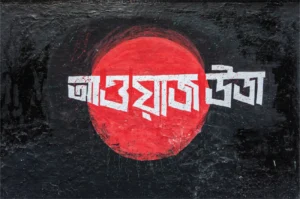Highlight

Graffiti Of Revolution
The essence of what Bangladesh witnessed last July-August, during a student-led protest, which emerged to a mass rage, turned into a blood-shading revolution. Eventually, it brought us what we now call a new Bangladesh. All that went through is difficult to put into words. Every single individual who was somehow part of the revolution—the ones who were out in the streets and directly witnessed both the brutalities and the togetherness of people; those who gave shelter and food to the protestors, took the injured for medical aid, and even those who kept the spirit alive in social media—the memories of July are firmly etched in everyone’s hearts, with their fair share of bitter sweetness. Given that visual communication is very impactful, visual materials played a vital role as a monumental catalyst in this revolution. While cartoons, photographs, and videos of the atrocities instantly circulated in social media almost every day, the graffiti mostly consisted of revolutionary and populist slogans on the city’s concrete, which acted as a source of constant inspiration for the ones who were on the street during the protest and even after the chaos was over. Graffiti, as an art form, has its own distinct raw flavour. Using graffiti as a tool for protest has always been a part of the biggest revolutions and mass uprisings in contemporary world history. The role of graffiti in the July-August revolution in Bangladesh is no different. Bangladesh has a long history of using graffiti as a form of protest. Graffiti was a common tool utilised by dissenting parties to express their disapproval throughout the Liberation War in 1971 and the political unrest of the 1980s. However, the pattern of graffiti we witnessed in July-August was comparatively unique, primarily because it represented a generation that many had assumed to be politically disengaged. Graffiti, or wall paintings, first emerged in New York in the ‘60s before spreadi ng worldwide. However, it has not taken root globally as profoundly as in Bangladesh. Reflecting on 53 years of post-liberation discrimination and turmoil, young students have distilled its essence through their art. During the anti-discrimination movement, Dhaka earned the title of the “graffiti capital” of the world. The walls became vast canvases of protest, adorned with creative and heartfelt slogans and poems that delivered powerful messages to the government. Furthermore, their graffiti themes did not only address particular political complaints but also lurking issues of social justice and human rights in Bangladesh. A significant number of these graffitis were direct one-liners spray painted by the students with a lot of risk during the tense times of the revolution. Even after achieving the desired victory through the revolution, new graffiti kept emerging, depicting the scenes of revolt, resistance, victory, and even more, including portraying the most memorable events and lines with humor. With utmost care, the concrete of the metropolis proudly holds these graffitis that reverberate the spirit of the revolution, acting as a memoir and constant reminder of what must not be forgotten.
Read More
